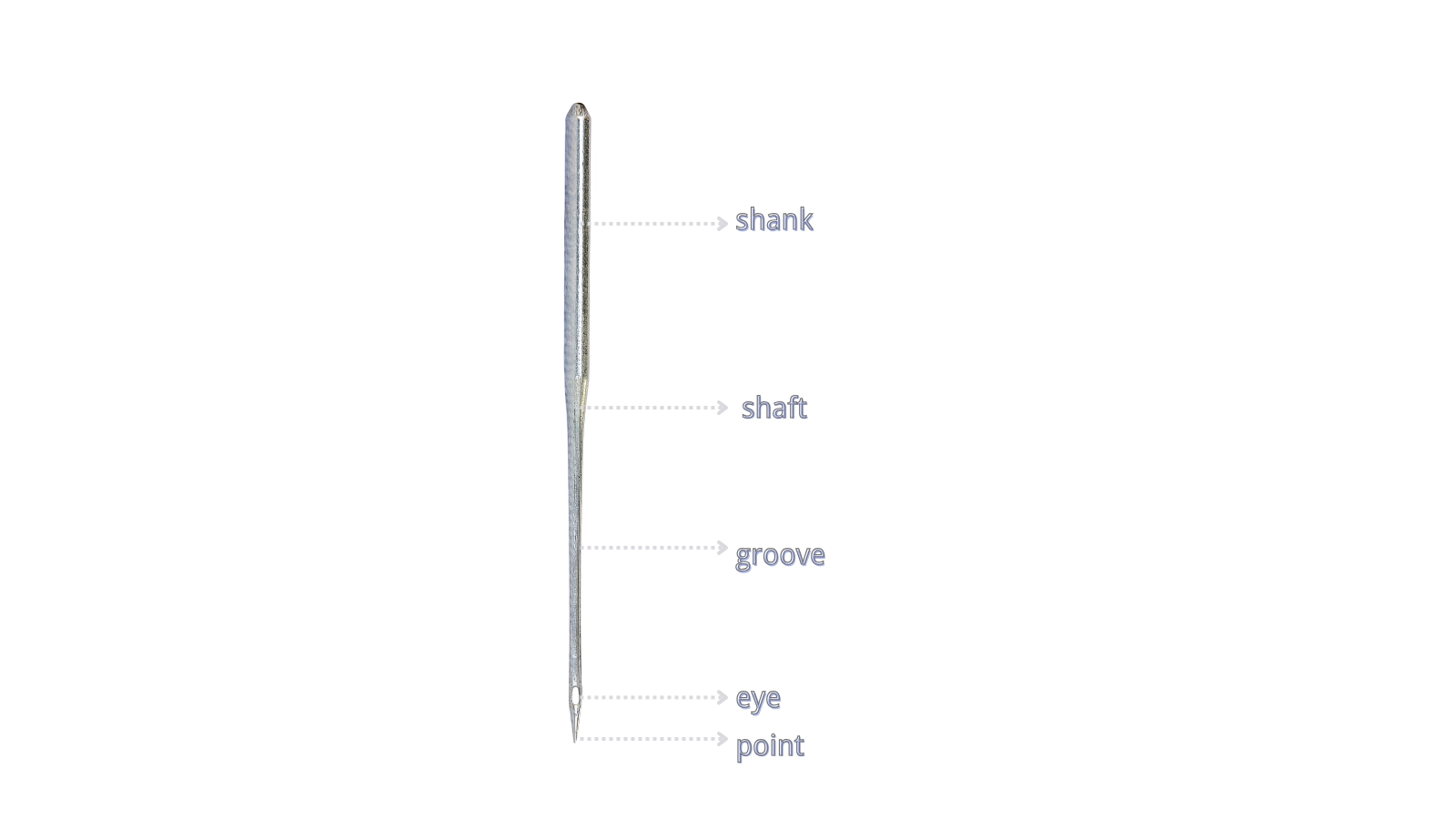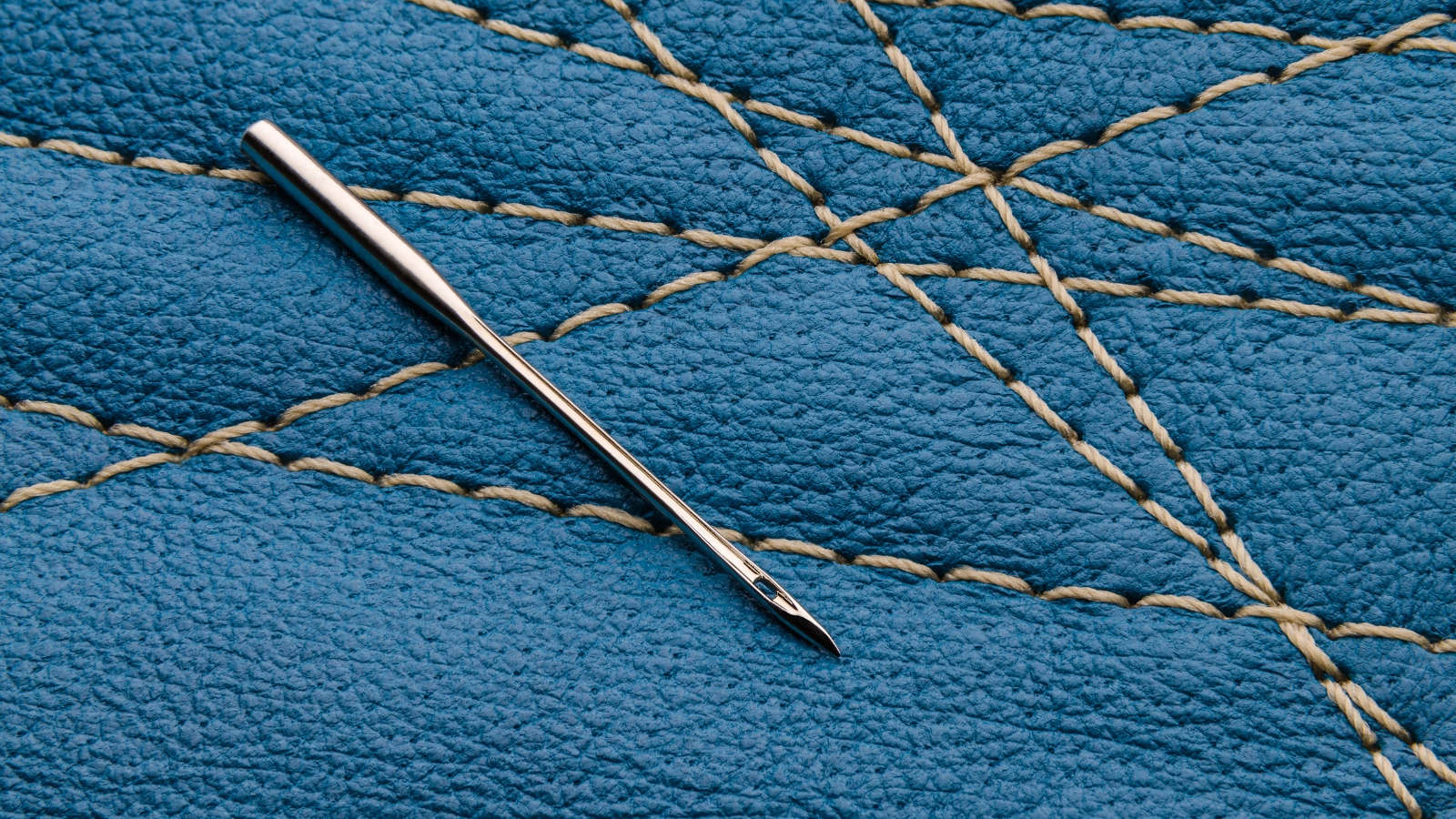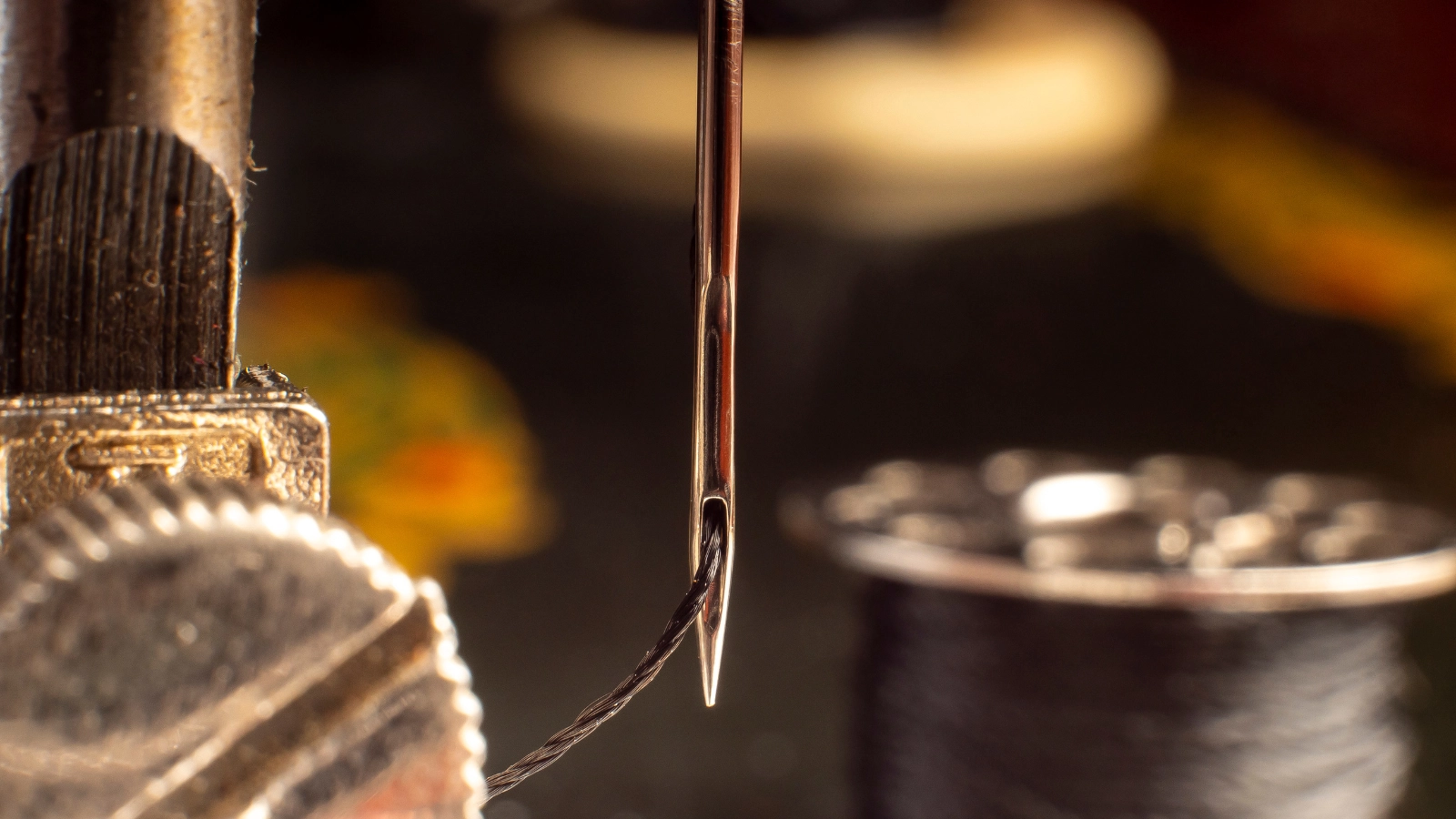The right sewing machine needle can make all the difference in achieving professional results. Beginners and even seasoned crafters often overlook sewing machine needle sizes. But they play a crucial role in the quality of your stitches and the overall outcome of your project.
Understanding the various types and sizes of needles can help you select the perfect one for your projects. In this article, we’ll explore the common sizes and types of needles and how they can elevate your sewing experience.
Key Takeaways
- Sewing machine needles use a dual-sizing system: European (60-120) and American (8-19).
- Size 60/8 suits delicate fabrics like silk and tulle. Size 100/16 works best for heavy materials like denim.
- Universal needles (80/12) are versatile for medium-weight materials. They serve as an excellent starting point for most projects.
- Lighter fabrics need smaller needles (60-70), and medium materials use middle sizes (80-90).
Basics of Sewing Machine Needles

To understand needle sizes, you first need to know the basics of sewing machine needles.
Anatomy of a Sewing Machine Needle
Four critical components work together to create perfect stitches: the shaft, eye, point, and groove.
- The shaft's thickness determines the needle size. Larger numbers show thicker needles.
- The eye, where you'll thread your machine, varies in size to match different thread types.
- The point's shape, whether sharp or rounded, penetrates specific fabric types effectively.
- A groove running along the needle's length guides your thread, ensuring smooth movement and proper tension throughout your sewing process.
How Needle Sizes Are Measured?
Sewing machine needle sizes follow a dual measurement system. They combine both metric and imperial standards for precise identification.
Metric measurements (European sizes) range from 60 to 110. This indicates the needle's diameter is hundredths of a millimeter, while imperial sizes span from 8 to 20. The thicker the needle, the larger the size number.
Common Sewing Machine Needle Sizes and Their Uses

Different needle sizes serve specific purposes. So, it's essential to know which one to use for each type of fabric.
1. Size 60/8
The size 60/8 needle represents one of the finest options in the sewing needle spectrum. It's specifically engineered for ultra-lightweight fabrics.
This fine needle excels with delicate materials like silk, tulle, and organza. It delivers precise stitching without damaging the fabric.
For ideal results, pair your 60/8 needle with 60-weight or lighter threads. This will prevent puckering and guarantee smooth seams.
2. Size 70/10
Size 70/10 is the next step up from ultra-fine needles. It delivers excellent performance for lightweight materials while maintaining precise stitch control.
Similarly, this needle excels with delicate materials like silk, taffeta, and organza. It's beneficial during detailed work such as appliqué and hemming.
When working with your 70/10 needle, you'll achieve superior results using finer threads.
3. Size 80/12
Size 80/12 represents a versatile middle ground in sewing machine needle selections. This medium needle is suitable for handling medium-weight materials, including quilting cotton, lightweight denim, and various blends.
The universal point of the 80/12 excels with both knit and woven fabrics. It also efficiently accommodates standard 40-50 weight threads.
4. Size 90/14
Size 90/14 needles are widely recognized among sewists. They serve as a cornerstone choice for medium-weight fabric applications.
This needle is perfect for cotton, linen, and various blends. It delivers ideal stitch definition and durability.
When working with thread weights between 40 and 50, the needle size 90/14 provides excellent performance.
It's especially effective for quilting projects and general garment construction. You can also confidently use this size when dealing with multiple fabric layers.
5. Size 100/16 and Above
For heavy-duty sewing projects, needle sizes 100/16 and above represent the powerhouse category.
Size 100/16 suits heavy materials like denim and canvas while easily accommodating thicker threads.
When you're quilting multiple layers, choose size 110/18 to handle thicker batting effectively.
For extreme durability, size 120/19 excels with leather and other tough materials.
These larger needle sizes feature reinforced shafts to prevent bending during intensive use.
Sewing Machine Needle Sizes: Specialty Needles
When selecting specialty needles, you'll need to match specific needle types to your project requirements.
1. Ball Point Needles
Ballpoint needles serve as the perfect choice for knit and stretchy fabrics. They feature a specially designed rounded tip. This tip pushes fibers aside rather than piercing through them. This design prevents damage and laddering common with standard needles.
You'll need to select the correct needle size based on your fabric weight. Use size 70/10 for lightweight knits and 90/14 for medium-weight materials.
When paired with the right cotton blend threads, ballpoint needles reduce skipped stitches and guarantee smooth seams.
2. Universal Needles
Because they offer exceptional versatility, universal needles serve as the go-to choice for most standard sewing projects.
These needles come in sizes ranging from 60/8 for lightweight materials to 100/16 for heavier fabrics.
Universal needles feature a slightly rounded point. They effectively works with wovens, synthetics, and some knits. They're also compatible with various thread types, including cotton and silk.
3. Stretch Needles
Stretch needles are designed specifically for elastic and knit materials. They feature a distinctive scarf modification that prevents skipped stitches during fabric manipulation. The rounded tip separates fabric fibers instead of piercing them. This maintains the integrity of stretchy textiles like Lycra and Power Net.
Stretch needles come in various sizes to match your fabric weight. Choose size 11/80 for medium-weight knit fabrics and size 14/90 for heavier elastic materials.
4. Quilting Needles
Quilting enthusiasts rely on specialized quilting needles to achieve professional results. These needles feature a tapered point and thicker shaft. These provide enhanced strength for penetrating dense materials and batting.
Choose your needle size carefully based on your project's requirements. The sizes range from 70/10 to 100/16. Lighter quilts work best with smaller sizes, while heavier projects demand larger needles.
5. Embroidery Needles
Machine embroidery demands specialized needles engineered for peak performance with decorative threads and intricate designs.
Embroidery needles feature a distinctly larger eye to accommodate thicker threads. They can prevent fraying and breakage during high-speed stitching.
Select needle sizes between 75/11 and 100/16 based on your fabric weight and thread thickness. The slightly rounded point creates clean stitches without damaging fibers. This ensures ideal stitch quality across various materials.
6. Leather Needles
Leather crafting demands specialized needles with distinct chisel-shaped points. These points can effectively pierce through tough materials.
Leather needle sizes range from 70/10 to 110/18, with larger sizes being essential for thicker leather projects. The reinforced shaft provides superior strength when working through multiple layers.
For peak results, pair your leather needle with strong polyester or nylon threads.
How to Choose the Right Needle Size

When selecting the ideal needle size, you'll need to consider both the fabric weight and thread thickness.
Choose size 9/70 for lightweight materials like silk, 11/80 for medium-weight materials such as cotton, and 16/100 for heavy fabrics like denim.
Match your thread weight to the needle size to maintain proper tension. A suitable choice guarantees excellent stitch quality and prevents common issues like puckering or skipped stitches.
Always test your selected needle on scrap fabric before starting your project. Plus, change your needles after every 6 hours of sewing time.
Common Sewing Problems Related to Needle Size
Using the wrong needle size can lead to various sewing issues. Here are some common problems related to needle size:
- Skipped Stitches: This occurs when the needle is too small or too large for the thread and fabric. The needle might not catch the bobbin thread properly, leading to skipped stitches.
- Needle Breakage: A too fine needle for thick or heavy fabrics can cause them to bend or break easily. Conversely, a thick needle on a delicate fabric can cause damage and breakage.
- Fabric Damage: A too large needle can leave visible holes or tears in lightweight fabrics. A too small needle might not penetrate heavier fabrics, causing puckering or snagging.
- Poor Stitch Quality: An incorrect needle size can lead to uneven or inconsistent stitch formation.
- Thread Breakage: If the needle eye is too small for the thread, it can cause excessive friction, leading to frequent thread breakage. Conversely, a too large needle can cause the thread to loop or knot.
- Machine Jamming: An incorrect needle size can cause thread bunching or tangling under the fabric. This will result in jams and requiring frequent stops to fix the issue.
To avoid these problems, match the needle size to the type of fabric and thread you are using. Always refer to the machine's manual for recommendations on needle sizes for different projects.
Conclusion
Selecting the correct needle is essential for your machine's best performance. Match your needle to both fabric weight and project requirements, ensuring proper thread clearance and minimizing deflection.
When you experience skipped stitches or fabric damage, verify you use the appropriate size-to-material ratio. Regularly inspecting and replacing the needle at 6-8 hours of sewing time maximizes efficiency.
Learn more sewing tips on the Longan Craft Blog, and dive into the fabric world with Longan Craft!
FAQs
How Do You Know What Size Sewing Needle to Use?
Match your needle size to your fabric's weight. Use 60/8 for delicate materials, 80/11 for medium-weight fabrics, and 100/16 for heavy materials. Always test on scrap fabric before starting your project.
What Is a 90-14 Needle Used for Sewing Machines?
A 90/14 needle is ideal for medium—to heavy-weight fabrics, such as quilting, denim, and cotton projects. Its larger eye accommodates heavier threads, making it perfect for multi-layer sewing tasks.
What Is the 80 12 Needle Used For?
Use an 80/12 needle for medium-weight fabrics like cotton, linen, and polyester blends. It's ideal for quilting cotton and knits. It delivers superior stitch formation with standard threads and prevents fabric damage.
What Is an 80-11 Sewing Needle Used For?
The 80/11 needle is ideal for medium-weight fabrics like quilting cotton, lightweight denim, and polyester. It's versatile enough for both woven and knit materials when used with universal or ballpoint needles.


0 comments